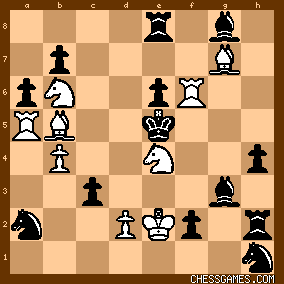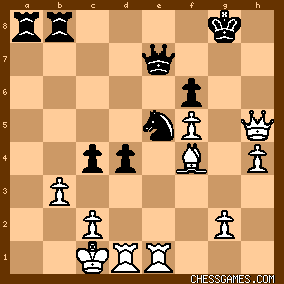| DrGridlock: This game appears in Bronstein's "200 Open Games" under the title, "A Three-mover of Samuel Loyd's." Bronstein writes that Matulovic missed, "real winning chances if he had ventured into uncharted waters with his king - 33 Kd2!!, but to have such impudence, one must be a chess composition fan and know the three-mover by Samuel Loyd, with the solution 1 Ke2!! which he dedicated to Steinitz. The position given by Bronstein in "200 games" is an incorrect statement of Lloyd's puzzle. A correct position can be found at: http://www.chessbase.com/puzzle/puz...
The suggested solution to the puzzle is Ke2, and Alain Wright writes, "The originality of the problem is due to the White King being placed in absolute safety, and yet coming out on a reckless career, with no immediate threat and in the face of innumerable checks. The freedom of the Black King to move, or to capture the Knight, constitutes a pretty feature of what may be looked upon as a remarkably bold theme." However, Lloyd's suggested solution is off by a couple moves. Komodo finds some additional resources for black. 
click for larger viewAnalysis by Komodo32 3 32bit:
1.  (#6): 1.Bc6+ Kd4 2.Rxe6+ Be5 3.Bxe5+ Kd3 4.Rxa2 cxd2 5.Nc5+ Ke3 6.Nc4# (#6): 1.Bc6+ Kd4 2.Rxe6+ Be5 3.Bxe5+ Kd3 4.Rxa2 cxd2 5.Nc5+ Ke3 6.Nc4# The quickest route is Bc6+, as after the suggested puzzle solution, Ke2, black is not required to queen his pawn on f8. 
click for larger viewAnalysis by Komodo32 3 32bit:
1.  (#4): 1...Rf8 2.Bd3+ Kd4 3.Rxf8+ e5 4.Rd8+ (#4): 1...Rf8 2.Bd3+ Kd4 3.Rxf8+ e5 4.Rd8+
But perhaps Bronstein's focus on the three-mover by Samuel Loyd blinded Bronstein to white's even better option - 33 Qg4! 
click for larger viewAnalysis by Komodo32 3 32bit:
1. ± (1.07): 33.Qg4+ Nxg4 34.Rxe7 Ne3 35.Bxe3 Ra1+ 36.Kd2 dxe3+ 37.Ke2 Rxd1 38.Kxd1 cxb3 39.cxb3 Rxb3 40.Ke2 Rb2+ 41.Kxe3 Rxg2 42.Kf3 Rg1 43.Rc7 Kf8 44.Rd7 Ke8 45.Ra7 Kf8 46.Kf4 Rg2 47.Rc7 Rg1 48.Rd7 Rh1 2. ± (0.80): 33.Kd2 c3+ 34.Ke2 d3+ 35.Kf1 dxc2 36.Rc1 Qf7 37.Qe2 Rxb3 38.Rxc2 Nc6 39.Qd3 Rd8 40.Qg3+ Kh7 41.Rxc3 Rg8 42.Qh3 Rxc3 43.Qxc3 Qd5 44.Bg3 Nd4 45.Re7+ Rg7 46.Rxg7+ Kxg7 47.Qc7+ Kh6 48.Kg1 Nxf5 3. = (-0.05): 33.Bxe5 c3 34.Qg6+ Kf8 35.Qh6+ Kg8 36.Qg6+ In summary:
(i) Bronstein saw the position in terms of Loyd's composition puzzle. (ii) the solution given by Loyd to his composition was slightly incorrect (iii) Bronstein's focus ignored the even better continuation for white. It's an interesting window into how Grandmasters evaluate positions in terms of recognized patterns, and how deep analysis of positions can sometimes improve on patterns and intuition. | 




